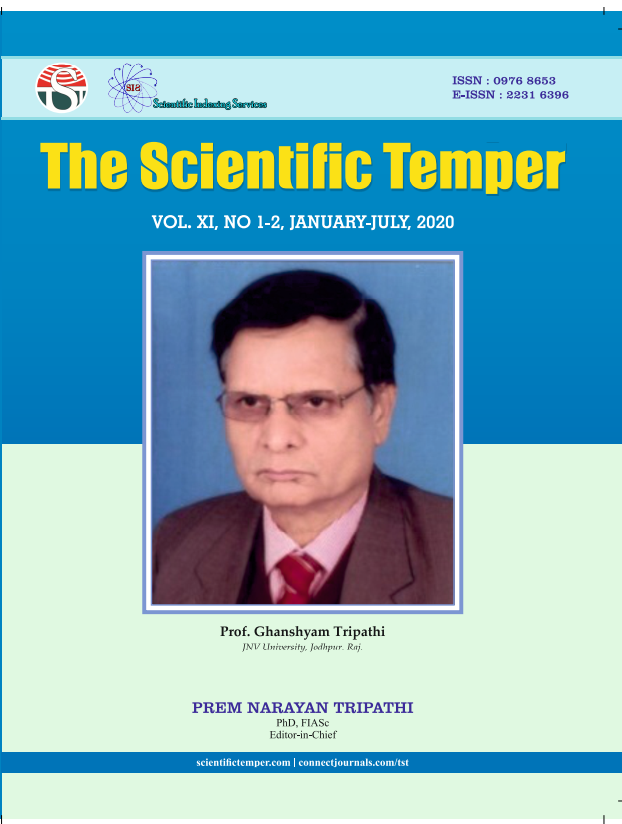Photoperiodic Supervision and Adaptability in Avian System
Downloads
Published
DOI:
https://doi.org/10.58414/SCIENTIFICTEMPER.2020.11.1.07Keywords:
Keywords:Photoperiodism, Photoperiod, Birds, Environmental stimuli, CuesDimensions Badge
Issue
Section
Photoperiodism is a prime selective force and in response to photoperiod and other supplementary environmental cues, birds exhibitbehavioral and physiological responses. Birds have developed specialized temporal programming for the adaptation to their activities during 24-h of periodicity. To maintain the successful survival of progeny, they use both environmental cues and endogenous cycles in the suitable time window of the year. These timing mechanisms commonly involve an internal molecular oscillator which we called as ‘clock’ (s) that is ‘entrained’ to the environmental cycle. They express their endogenous cycles in physiology and behavior by receptor mechanisms responding to appropriate environmental signals (‘Zeitgeber’, i.e. time-giver) that allow anticipation of the seasons. Birds can respond to environmental stimuli in 3 key ways: disperse, adjust through phenotypic plasticity, or adapt through genetic changes. In this article, we discussed thesignificance of ecological factors affecting bird’s physiology and behavior.Furthermore, the migratory songbird’s performancealong with downstream proceedingsabout these factors and their adaptive approaches towards nature’scircuitryAbstract
How to Cite
Downloads
Similar Articles
- Shanmuganathi Ayyankalai, Srinivasaragavan Subburaj, Prasanna Kumari Nataraj, Measuring the research productivity on environmental toxicology: A scientometric study , The Scientific Temper: Vol. 16 No. 01 (2025): The Scientific Temper
- Brij M. Sharma, Parul Singhal, Neeraj Uniyal, Ram T. Mourya, Jai Sharma, Community based seasonally water quality testing of tributaries of Dehradun , The Scientific Temper: Vol. 15 No. 03 (2024): The Scientific Temper
- Seema Yadav, Problems and Perspectives in Sustainable Environment in the World: A Legal Study , The Scientific Temper: Vol. 12 No. 1&2 (2021): The Scientific Temper
- Arvind Kumar, R.K. Pandey, Isha Choudhary, D.K. Sharma, S.K. Bhardwaj, ROLE OF TESTOSTERONE ON BODY MASS, BODY MOLTS, PRIMARY FLIGHT FEATHERS, PLUMAGE REGENERATION AND TESTES IN BRAHMINY MYNA (STURNUS PAGODARUM) , The Scientific Temper: Vol. 1 No. 01 (2010): The Scientific Temper
- N. Yogalakshmi, Awareness on environmental issues and sustainable practices among college students - with special reference to Chennai city region , The Scientific Temper: Vol. 16 No. Spl-2 (2025): The Scientific Temper
- Sunil Khati, B. R. Jaipal, Feeding Habits of Birds in the Narmada Canal Region of Rajasthan , The Scientific Temper: Vol. 13 No. 02 (2022): The Scientific Temper
- JAY SHANKAR SINGH, D.P. SINGH, R.K GUPTA, GENETICALLY MODIFIED PLANTS : BENEFITS AND ENVIRONMENTAL PROBLEMS , The Scientific Temper: Vol. 2 No. 1&2 (2011): The Scientific Temper
- Alka Ranjan, Evaluating mental well-being and environmental sustainability in Indian stories , The Scientific Temper: Vol. 16 No. Spl-1 (2025): The Scientific Temper
- Manan Pathak, Dishang Trivedi Trivedi, Field-effect limits and design parameters for hybrid HVDC – HVAC transmission line corridors , The Scientific Temper: Vol. 16 No. Spl-1 (2025): The Scientific Temper
- Manju Yadav, B.P. Singh, A Study of Environmental Awareness and Academic Achievement of Under-Graduate Tribal Students in Satna District (M.P.) , The Scientific Temper: Vol. 12 No. 1&2 (2021): The Scientific Temper
You may also start an advanced similarity search for this article.



